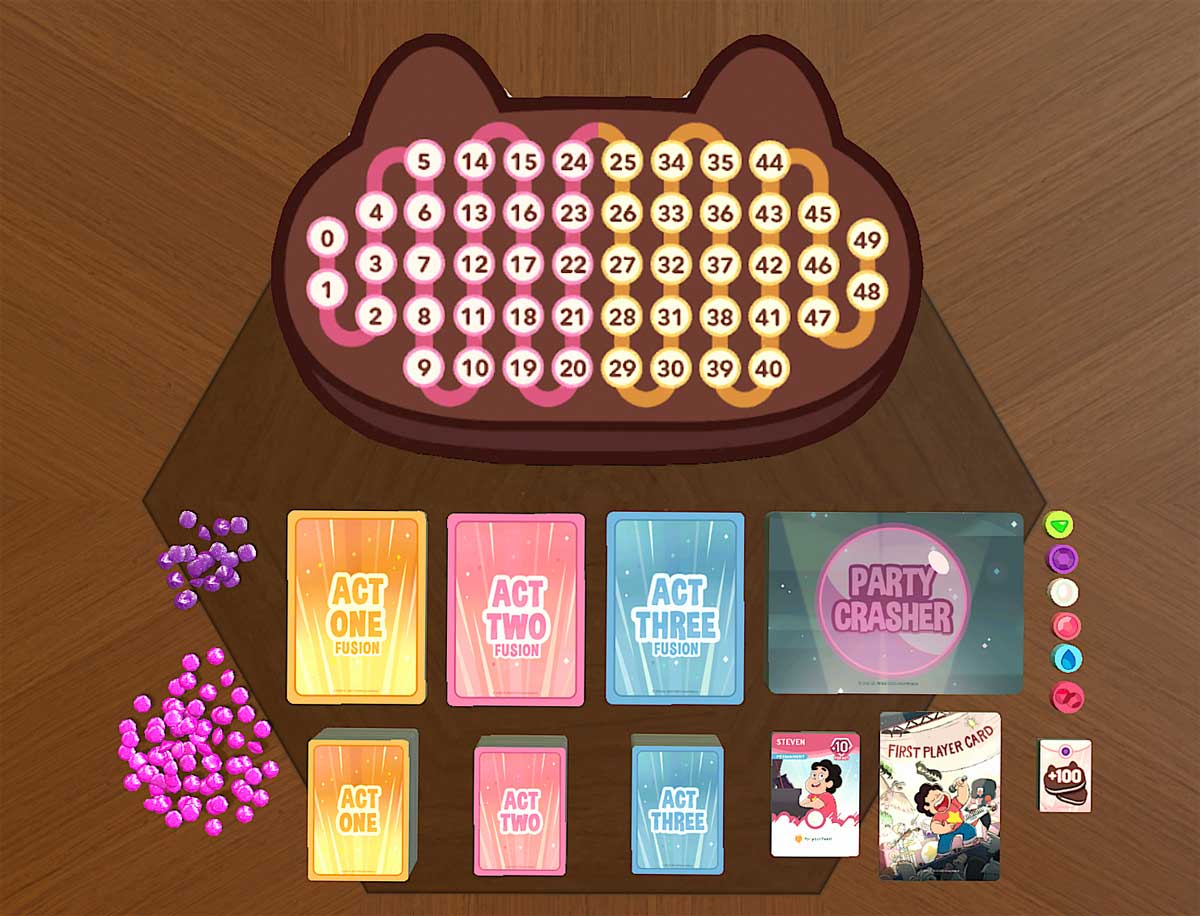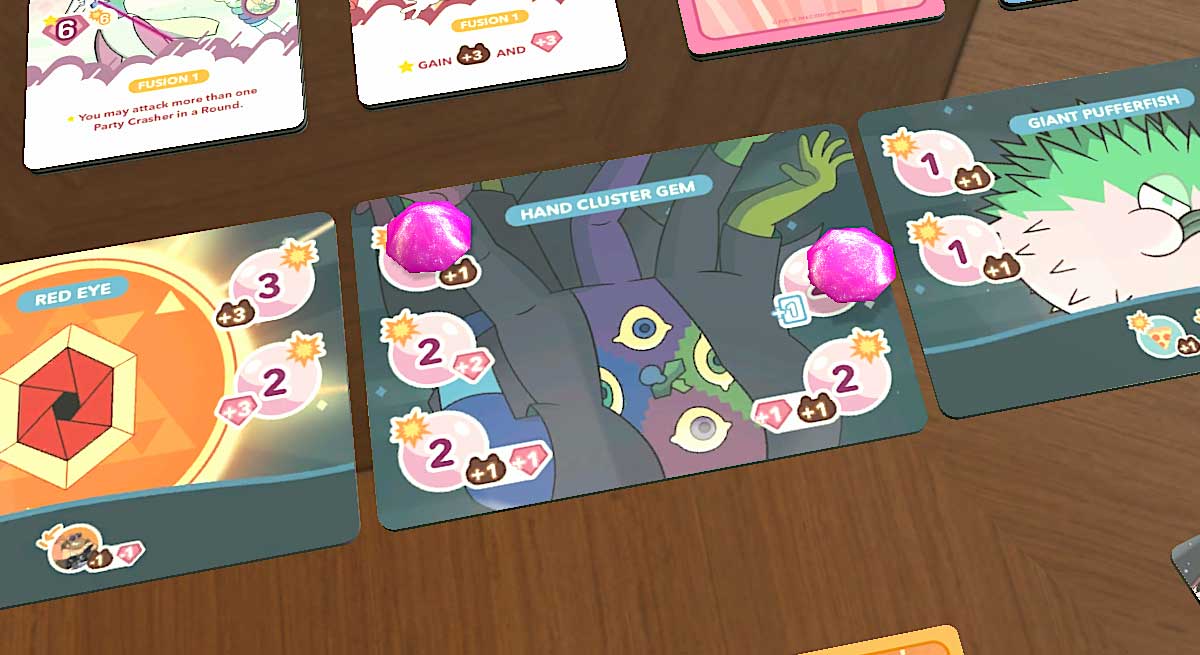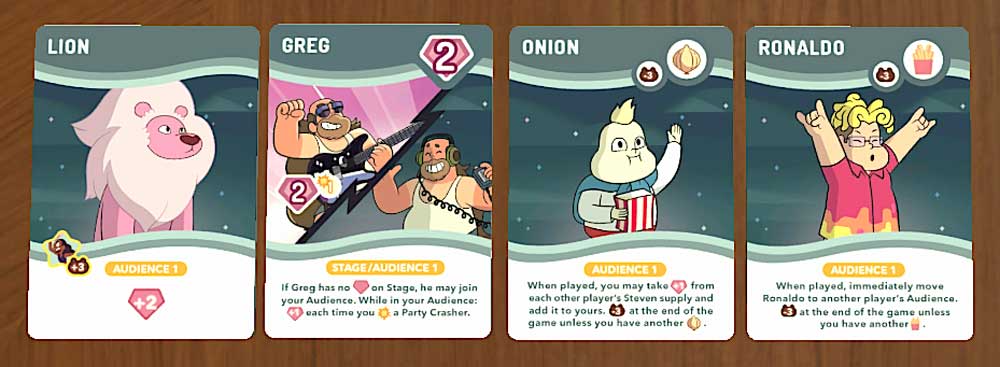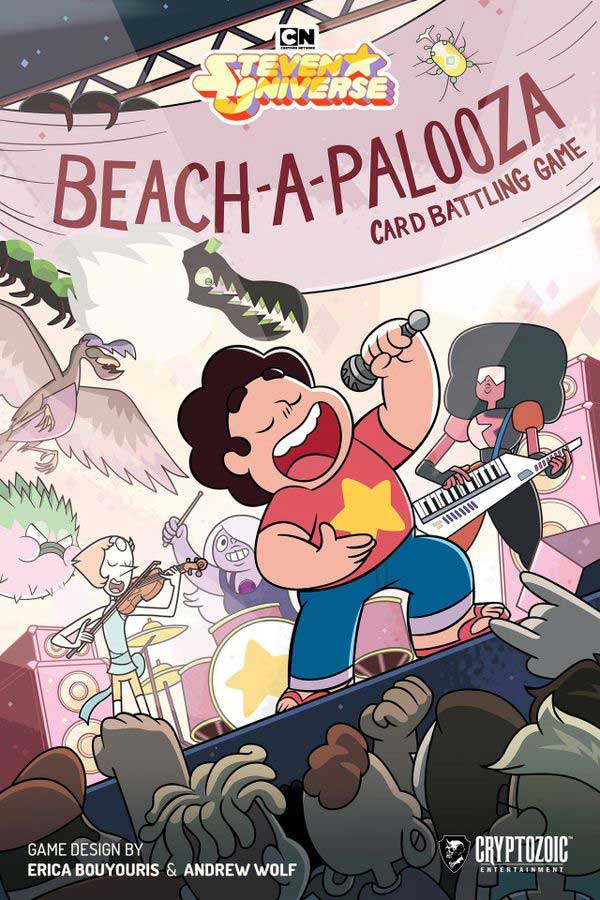Join Steven Universe and his friends for Beach-a-Palooza! Recruit your band members, attract an audience, and don’t forget about those pesky party crashers.
What Is Steven Universe: Beach-a-Palooza?
Steven Universe: Beach-a-Palooza is a card game for 2 to 6 players, ages 10 and up, and takes about 45 to 60 minutes to play. It’s currently seeking funding on Kickstarter, with a pledge level of $30 (plus shipping) for a copy of the game. The game takes place in the world of the Steven Universe cartoon (as seen on Cartoon Network) and so the presence of certain characters may be spoilers for the show; however, knowledge of the show is not required to play the game. There are some cartoony monsters and simulated battles, but the game should still be appropriate for kids to play.
Steven Universe: Beach-a-Palooza was designed by Erica Bouyouris and Andrew Wolf and is published by Cryptozoic Entertainment. It was originally planned to be released at San Diego Comic-Con this weekend, but of course due to the pandemic, both Comic-Con and retail store plans were severely impacted. It is a Kickstarter exclusive and will not be available in regular retail later, in part because of how the licensing with Cartoon Network works. There’s only about a week left in the Kickstarter campaign, so don’t wait too long to check it out!
If you’re a fan of Steven Universe but you’re not familiar with Kickstarter, you may want to check out our crowdfunding primer for a little more background on how it works.

Steven Universe: Beach-a-Palooza Components
Note: I was able to play a demo of the game in Tabletop Simulator, but haven’t had access to a physical prototype, so all of my images are screenshots within TTS. I’m not sure about the relative size of all of the components, because some of them (like the plastic gems) were enlarged a bit in TTS to make it easier to handle in that interface.
Here’s what will come in the box:
- Cookie Cat scoreboard
- 20 Dark Pink gems
- 70 Light Pink gems
- 11 Fusion cards (in 3 Acts)
- 162 Act cards (in 3 Acts)
- 30 Party Crasher cards
- 6 Score Tracker gems
- 6 Steven Universe cards
- First Player card
- 6 Score Overflow cards
- 6 Player Aid cards

The cards in the game feature all of your favorite (and least-favorite) characters from the world of Steven Universe: the Act cards include several Gems as well as the various citizens of Beach City. The Party Crashers consist of Homeworld Gems and many of the corrupted Gem creatures that have appeared on the show. The artwork looks straight out of the show (though I should note that it’s not simply screenshots from episodes).
The scoreboard is a big Cookie Cat silhouette, and Erica Bouyouris showed me that the back of the board has the Cookie Cat face so you can pretend to be enjoying this giant-sized pet for your tummy. (Super duper yummy!) The scoring tokens will be little translucent discs with the various gem icons on them.
The card images you’ll see in this post are finalized artwork so everything is pretty much accurate (other than some typo fixes). I felt like some of the icons (in particular, the attack values from the on-stage characters) were a little small, though it’s hard to tell whether that’s simply a matter of how it appears in Tabletop Simulator.
How to Play Steven Universe: Beach-a-Palooza
You can download a copy of the rulebook here. I’ll give a brief overview of the game but won’t get into a lot of the details.
The Goal
The goal of the game is to score the most points by the end of three acts; points are typically scored by successfully attacking Party Crashers, but there are a few other ways to score points as well.

Setup
Place the Cookie Cat scoreboard in the center, with everyone’s scoring token at the 0 space. Place the Act One fusion cards face-up in the play area, with the Act Two and Act Three face-down. (The exact number used is based on player count.) Shuffle the Party Crasher deck and reveal three cards.
Shuffle each of the Act decks separately. Deal each player 9 cards from Act One.

Each player gets a Steven card and places it face-up in front of them, starting their “stage.” Each Steven card has a gem icon in the center corresponding to the scoring tokens; some give extra attack to specific Gems, and others will give bonuses for having certain character types in the audience. (Note for the uninitiated: there’s a time-travel episode where Steven manages to travel back in time, making an extra copy of himself each time and forming a band—though of course not everything goes well.)
Each player also gets 10 energy (crystals) to start, placed on their Steven card.
Give the First Player card to the person who most recently watched Steven Universe.
Gameplay
The game takes place over 3 Acts, each with 3 rounds of play. During each round, players will draft cards and attempt to attack Party Crashers.

Everyone selects 3 cards from their own hands and does the following simultaneously:
- One is put on your stage next to Steven; you must pay enough energy (from Steven) to meet the card’s cost shown at the top right, putting that energy on the new card. You may only have 3 characters on stage along with Steven, but you can discard them to make room (except for Steven!). Some characters have immediate effects when played.
- One is put in your audience, which immediately triggers its benefits, if applicable. Audience members can let you gain or transfer energy, score bonus points, or have even more complex effects. Some will also be worth points if you get groups of them.
- One is placed next to the scoreboard—these characters have been kidnapped by the Party Crashers and can be rescued. Both stage and audience characters can be put in this area.
There are some other details about playing cards, but that’s the gist. You can’t have multiple copies of the same character, for instance, but you can replace a character with a copy to re-trigger its effect (or get a free energy refill, in the case of a stage character). If you can’t or don’t want to play a card to your stage or audience, you can discard one instead.
Once everyone has played their three cards, the attack phase happens in turn order.

Each of your characters on stage can attack one Party Crasher (though different characters may attack different Party Crashers). Your characters must spend energy to attack—most of them have two options, either spending half of their energy or all of their energy for different attack values. The Party Crashers have various spots showing a different attack value; each of your characters may divvy up their attack power among these spots. Each spot has its own rewards: points (Cookie Cat icon), energy (gem icon), or rescue a card from the common area (card icon) and play it in its appropriate location. In addition, you might gain bonuses from audience members, your Steven, or even from some Party Crashers, who are particularly vulnerable to specific characters.
If you fill in the last attack spot on a Party Crasher, you’ve defeated it! You get a reward of 3 points or rescue one character from the common area and play it. Clear the Party Crasher card and flip it over (the back of the cards show a bubble, symbolizing the way the gem is trapped in a bubble on the show) and set it aside, drawing a new Party Crasher from the deck to replace it.

What would Steven Universe be without some Fusions? (Fusions are a bit like Voltron: the Gems have the ability to join into giant, melded versions that take on characteristics of their members.) Each of the Fusion cards shows which Gems are required to form it (and each Gem card also shows which other Gems it can fuse with).
Before your attack, you may form a Fusion if you have the right Gems, and if together they have enough energy to pay the cost. The Fusions have different special effects, as well as some bigger attack values to finish off those Party Crashers. At the end of your attack phase, the Fusion is returned to the center area and your separated Gems remain on your stage. Note that some Party Crashers will have negative effects depending on who’s in your audience or on your stage, so you’ll want to bubble them as quickly as possible!

Once everyone has attacked, pass your remaining cards to your left, and then repeat. At the end of three rounds, everyone will be out of cards and it’s time to start the next Act.
For the remaining two Acts, use the corresponding decks, dealing players 9 cards as before. Everyone gets 10 more energy at the beginning of each Act. Also, you reveal the corresponding Fusion cards, which are now available. (These correspond to Fusions that show up in later seasons of the show!)

Game End
The game ends at the end of three Acts. Players will score bonus points for collecting multiple characters from the same set, like the Fry family, Cool kids, or Big Donut. Also, players will score bonus points for having the most energy left over.
The highest score wins, with ties going to the player with the most energy in their supply.
Why You Should Play Steven Universe: Beach-a-Palooza
I got into Steven Universe (the show) a bit late: my teenage daughter had seen it and talked about it from time to time, but it wasn’t until it was released on DVD that I finally got around to watching it for myself, and I loved it. We ended up purchasing the rest of the seasons to stream, and then watched the movie together when it came out last year. Now, I don’t know the show as well as some of the superfans out there, but it’s a show that I don’t hesitate to recommend.
So I was definitely excited when I heard that Erica Bouyouris was working on a Steven Universe game. She’s also the designer of the Scott Pilgrim miniatures game that was funded on Kickstarter last winter, and I was curious to see what she’d do with the world. She and co-designer Andrew Wolf are both fans; she told me that when Cryptozoic got the license from Cartoon Network, they wanted to find somebody who knew the show well. I can confirm: when I played a demo with Bouyouris over Tabletop Simulator, she pointed out little details about characters and their effects that are based on plotlines from the cartoon. (And her kid peeked in to watch us playing, and was excited to see when various characters showed up during the game.)

For instance, there are some characters who show up in more than one Act, but they evolve. In the image above, you can see a few examples: Lars is part of the Cool Kids set and the Big Donut set in Act One, but by Act Three he’s no longer a Cool Kid. Meanwhile, Nanefua becomes Mayor while (former) Mayor Dewey goes to work at the Big Donut.
Now, these are little details that fans of the show will appreciate, but that you don’t really need to know in order to play the game. If you just like card games but you don’t know anything about Steven Universe, you could treat it like any other fantasy game where there may or may not be some backstory to the characters you see on the cards, but it’s not spelled out within the game itself.
As far as the gameplay itself goes, it’s a light-to-medium weight in terms of strategy, which I think is appropriate: the game is in that tricky position where it should appeal to fans of the show who don’t necessarily play a lot of games, but also to people who play games but aren’t familiar with the show. (Of course, if you like the show and you play a lot of games, then you’re the perfect audience for it.) With the cancellation of Comic-Con, I think that puts Steven Universe: Beach-a-Palooza in a particularly unfortunate spot, since the more casual gamers who may have picked it up at a convention may not be as likely to seek it out on Kickstarter, where the game-backing crowd tends to favor bigger, more complex games. If you primarily play heavier strategy games, Steven Universe: Beach-a-Palooza may not be quite what you’re looking for. I think there’s a decent amount of decision-making in the game, but it’s fairly accessible so it doesn’t get too complex.
My big disclaimer here is that I’ve only gotten to play the game once myself, over Tabletop Simulator, so I haven’t had the benefit of repeated plays to try out different approaches. However, I was able to flip through the cards after we finished to get a sense of the different effects on the various cards so I could see how different combinations of characters could really change things up. In a 2-player game, there are a lot of cards that won’t get used, but in a 6-player game you’ll see just about every card in the Act decks.
During the card-drafting phase each turn, you only get to add two cards to your tableau, one to your stage and one in your audience. For the stage, you have to consider how much energy it will cost and whether you can afford it, as well as the amount of attack power it will provide. For the audience, you may have to decide between the set-collection of trying to get one more Onion character, or getting some more energy if you’re running low. Some characters let you refuel from your Steven energy supply—but without those, you might have a great character on stage who doesn’t get to do anything for a round. Even the character you put into the common area can be an important choice: will you be able to finish off a Party Crasher and rescue somebody this turn? If so, you might get to choose your third card. Alternatively, you may use this choice to remove a card that your opponent needs so that they can’t simply play it from their hand on the next turn.

Figuring out your attack plan is where it can get a little mathy, since each individual character’s attacks have to be focused on a single Party Crasher. You want to get as much out of your attacks as possible, but you usually don’t want to leave a Party Crasher with just a few hits left, because one of your opponents will get the bubble bonus. That’s not to mention the various bonuses or penalties for some of the Party Crashers based on people in your audience or on your stage, which can feed into those decisions as well.
I’m excited for Steven Universe: Beach-a-Palooza because I think it’s a game that my daughters will enjoy playing with me, and it gives us a way to spend a little more time in a world that we all enjoy. If you’re a fan of the show or even just a collector of fun Steven Universe stuff, it may be worth it simply because it’s uncertain whether it will ever get reprinted (because that would require Cryptozoic to re-license it from Cartoon Network). If you’re a tabletop gamer who hasn’t watched the show, now’s as good a time as any! Back the game, binge the show, and then by the time it arrives near the end of the year, you’ll be fully immersed in the lore.
I know the most common concern about licensed IP games: does it actually have anything to do with the show, or was it simply a theme slapped onto an existing, mediocre game concept? Is it the equivalent of [Insert Your Town Here]-opoly? I feel pretty comfortable saying that isn’t the case here: this title was designed from the ground up to be a Steven Universe game, and although it doesn’t encompass the whole of the series, it does feel like a moment that fits in that world.
For more information or to make a pledge, visit the Steven Universe: Beach-a-Palooza Kickstarter page!
Click here to see all our tabletop game reviews.
![]() To subscribe to GeekDad’s tabletop gaming coverage, please copy this link and add it to your RSS reader.
To subscribe to GeekDad’s tabletop gaming coverage, please copy this link and add it to your RSS reader.





